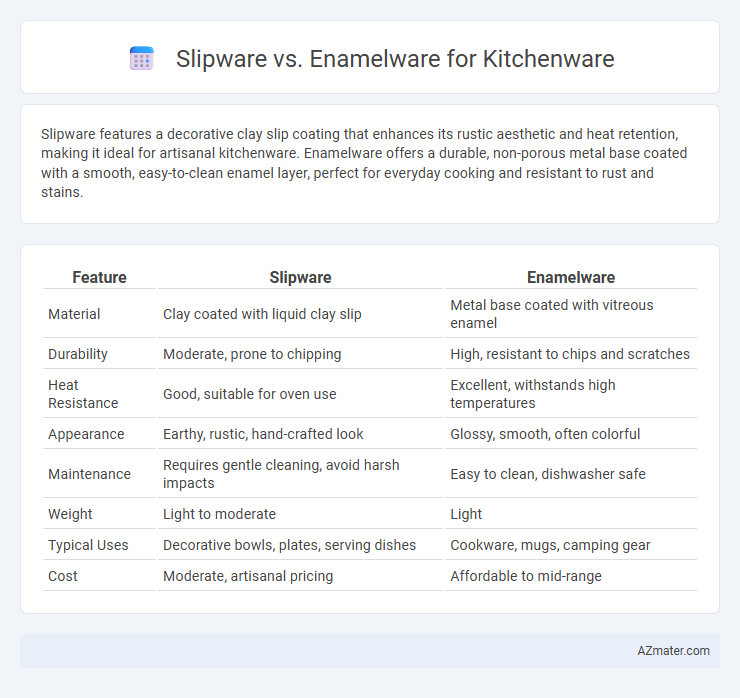Slipware features a decorative clay slip coating that enhances its rustic aesthetic and heat retention, making it ideal for artisanal kitchenware. Enamelware offers a durable, non-porous metal base coated with a smooth, easy-to-clean enamel layer, perfect for everyday cooking and resistant to rust and stains.
Table of Comparison
| Feature | Slipware | Enamelware |
|---|---|---|
| Material | Clay coated with liquid clay slip | Metal base coated with vitreous enamel |
| Durability | Moderate, prone to chipping | High, resistant to chips and scratches |
| Heat Resistance | Good, suitable for oven use | Excellent, withstands high temperatures |
| Appearance | Earthy, rustic, hand-crafted look | Glossy, smooth, often colorful |
| Maintenance | Requires gentle cleaning, avoid harsh impacts | Easy to clean, dishwasher safe |
| Weight | Light to moderate | Light |
| Typical Uses | Decorative bowls, plates, serving dishes | Cookware, mugs, camping gear |
| Cost | Moderate, artisanal pricing | Affordable to mid-range |
Introduction to Slipware and Enamelware
Slipware is a type of pottery decorated with slip, a liquid mixture of clay and water, applied before firing to create intricate patterns and textures, often showcasing a rustic, handmade aesthetic. Enamelware consists of metal objects coated with a smooth, durable layer of porcelain enamel, providing a non-porous, heat-resistant surface ideal for cooking and serving. Both materials offer unique functional and decorative qualities, affecting their suitability for various kitchen tasks.
Historical Background of Slipware
Slipware, a form of pottery decorated with liquid clay called slip, dates back to ancient civilizations such as the Romans and Chinese during the Tang dynasty, valued for its decorative and functional qualities. This technique flourished in medieval Europe, especially in English and Dutch pottery traditions, where artisans created intricate designs by applying slip to earthenware before firing. In contrast to enamelware, which emerged in the 19th century as a durable, metal-based kitchenware option coated with glass-like enamel, slipware represents an older, artisanal ceramic heritage focused on handcrafted aesthetics and historical craftsmanship.
Origins and Development of Enamelware
Enamelware originated in the early 19th century, evolving from traditional metal cookware coated with a vitreous enamel layer to prevent rust and enhance durability. Its development was driven by advancements in industrial manufacturing, allowing mass production of lightweight, heat-resistant kitchenware often made from steel or iron bases. In contrast, slipware traces back to ancient pottery techniques using liquid clay slip for decorative finishes, emphasizing artisanal handcrafting rather than industrial processes.
Material Composition: Slipware vs Enamelware
Slipware kitchenware is made from clay coated with a liquid mixture of clay and water called slip, which is often decorated with patterns before firing, resulting in a porous, rustic finish suited for artisan cookware. Enamelware consists of metal, typically steel or cast iron, coated with a smooth layer of vitreous enamel, providing a durable, non-porous surface resistant to corrosion and easy to clean. The material composition of slipware emphasizes natural, ceramic qualities, while enamelware combines metal strength with a protective glass-like coating for enhanced kitchen durability.
Durability and Longevity Comparison
Slipware features a porous clay body coated with a liquid clay slip, offering moderate durability but prone to chipping and cracking under heavy use. Enamelware consists of metal coated with a smooth, durable enamel glaze, providing superior resistance to scratches, heat, and corrosion, resulting in a longer lifespan. For kitchenware, enamelware outperforms slipware by maintaining structural integrity and aesthetic appeal over extended periods in daily cooking environments.
Design Aesthetics and Patterns
Slipware kitchenware showcases hand-applied slip decoration, offering unique, earthy patterns with a tactile, rustic feel that emphasizes artisanal craftsmanship. Enamelware features smooth, glossy surfaces with vibrant, often solid or speckled color palettes, providing a sleek, durable finish ideal for modern and retro-inspired designs. Both materials present distinctive visual styles: slipware appeals to those seeking organic, textured patterns, while enamelware attracts users preferring bright, polished aesthetics with easy-to-clean surfaces.
Functionality in Everyday Cooking
Slipware offers excellent heat retention and distribution, making it ideal for slow cooking and baking, while its porous surface allows it to absorb flavors, enhancing dishes over time. Enamelware features a smooth, non-porous coating that resists staining and is highly resistant to acidic foods, providing easy cleaning and durability in everyday use. Both materials are versatile, but slipware excels in flavor development, whereas enamelware stands out for its low maintenance and hygienic cooking experience.
Safety and Health Considerations
Slipware, made by applying liquid clay slip onto ceramics, is generally safe for kitchenware but may contain lead or other heavy metals if not properly glazed, posing potential health risks. Enamelware, created by fusing powdered glass to metal at high temperatures, offers a non-porous, durable surface that resists chipping and is typically free from harmful chemicals, making it a safer choice for food contact. Both materials require certified food-safe coatings to ensure safety, with enamelware often preferred for its resistance to bacteria and ease of cleaning.
Maintenance and Cleaning Tips
Slipware kitchenware requires gentle handwashing with mild detergent to preserve its decorative slip coating and avoid chipping. Enamelware offers easier maintenance due to its smooth, non-porous surface and can often be cleaned in a dishwasher without damage. Both materials benefit from avoiding abrasive scrubbers and harsh chemicals to prolong their appearance and functionality.
Choosing the Right Kitchenware: Slipware or Enamelware?
Slipware offers a handcrafted aesthetic with natural, earthy textures ideal for rustic or artisanal kitchen themes, while enamelware provides a durable, non-porous surface resistant to stains and scratches, perfect for heavy daily use. Slipware's porous clay makeup requires careful handling and seasoning to prevent moisture absorption, whereas enamelware features a metal core coated in vitrified enamel suitable for stovetop and oven use. Selecting between slipware and enamelware depends on prioritizing either artisanal beauty and craftsmanship or practicality and durability in kitchenware.

Infographic: Slipware vs Enamelware for Kitchenware
 azmater.com
azmater.com